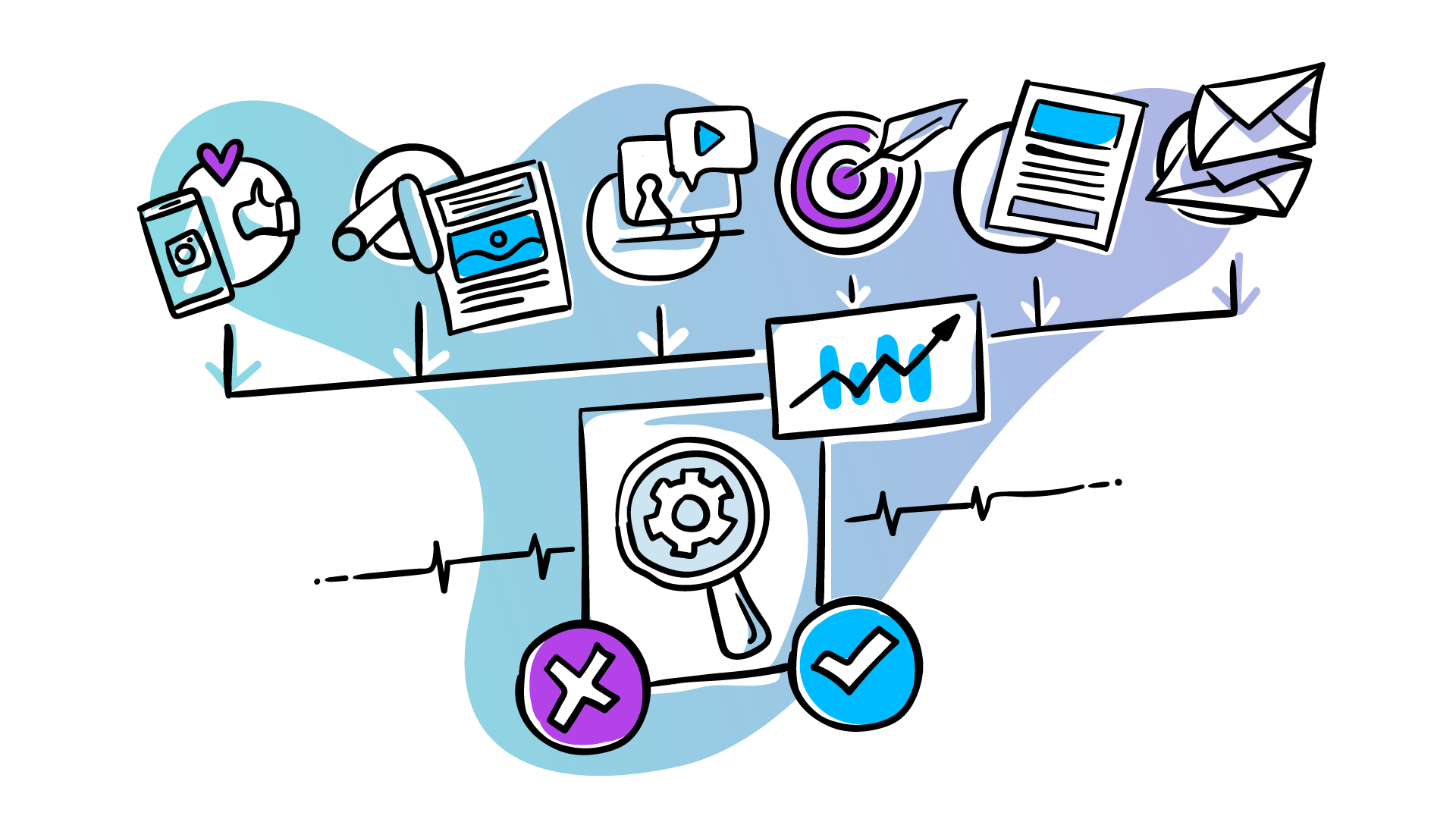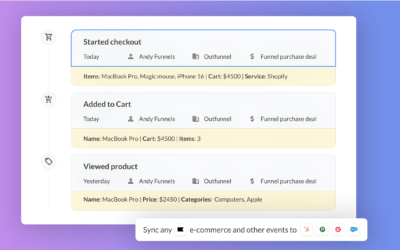Good news: the number of tools for digital marketing is continuously increasing.
The not-so-good news: keeping track of what’s working and what’s not has become even more challenging.
Thankfully, getting familiar with marketing attribution will make things much easier for you!
Imagine a customer sees your Google ad, clicks on it, subscribes to your blog, and buys your product from the second email you send them. Now, who should get the credit?
Is it the Google ad you have been running for a month, because it has driven the customer to the website?
Or is it the email flow that convinced the customer to make a purchase?
Apparently, many other marketers have asked these very questions. So, it is no surprise that the global marketing attribution software market is expected to exceed US$ 4.5 billion by 2026 according to research.
In this article, we will highlight different aspects of marketing attribution such as:
- What marketing attribution is;
- What the attribution models are;
- How it helps your business grow;
- How Outfunnel can help you with attribution.
Let`s get started with marketing attribution: what is it and why does it matter?
What is marketing attribution?
Marketing attribution is the value you assign to a particular marketing channel based on its success. It shows you what marketing channels are converting and any other success metrics you set based on your business goals.
In other words, attribution answers the question of which platform will get the credit for conversion – what`s working and what`s not – through relevant data analysis.
Now, you may ask “I`m already checking lots of metrics on Google Analytics. What`s the difference?”
The answer is, attribution takes marketing analytics to a deeper level.
While it is relatively easy to track link clicks, website behavior or traffic separately, the real challenge lies in connecting the dots between each action the user takes throughout the buying process.
If you`ve been running FB Awareness ads, re-targeting the same audience with lead forms, organizing webinars, and nurturing those leads with email flows, which one of those is to be congratulated when there is a purchase?
Acting as a bridge between marketing and sales, marketing attribution aims to find the channels that drive revenue.
Once you know those channels, you continue doing what`s working and stop doing what`s not working.
Tip: All businesses are different, and so are their needs.
There is not a one-size-fits-all approach when it comes to marketing attribution practices.
Before getting started, always keep your business goals in mind, take into consideration the complexity of your customer journey, and pick the attribution model that aligns with those points. Which leads us to…
What are the marketing attribution models?
In the first section, we have covered what marketing attribution is and what it means for your business.
Now let`s jump into the three main attribution models you can use to track touchpoints in your sales cycle.
- Single-source attribution
- Multi-source attribution
- Weighted Multi-source attribution
Before reading on, keep in mind that while there is no such thing as the best attribution model. Your business targets and customer journey are what matter the most before selecting the right model.
Single-source attribution
This model is divided into two categories.
- First-touch attribution: As the name suggests, it takes into consideration the first channel the customer engaged with.
- Last-touch attribution: This model gives the credit to the last point before the sale.
Let`s say a customer clicked on your Google ad, downloaded a brochure, had a sales call with your Sales team, and then purchased the product.
According to the First-touch model, the best converting channel would be the Google Ad campaign.
If you use the Last-touch approach, it would be the sales call.
Multi-Source Attribution
The customer journey is not linear anymore which leads marketers to develop more complex marketing strategies to reach their target audience.
The Multi-source approach gives credit to each channel used in the journey and suggests different models.
Below are what these models are called and what they give credit to in the sales cycle:
- Linear: Equal credit to all the touchpoints.
- Time Decay: More recent marketing touchpoints.
- U-Shaped: The first touch (when the customer interacts for the first time) and the lead creation (when a customer fills in a form with name, last name, email, etc).
- W-Shaped: The first touch, lead creation, and the opportunity creation (when you add a customer`s info to your company CRM as it`s a good fit and considered as an “opportunity”).
- Full Path: The first touch, lead creation, opportunity creation, and final close (when the opportunity converts into a customer – the sometimes short, sometimes long-awaited “YAY” moment in the sales process).
Custom: Takes into account the specific needs and sales cycle of the company.
Weighted Multi-source Attribution
This model assigns value to all the interactions throughout the customer journey.
The difference from the previous model is that Multi-source attribution gives credit to the best performers in the marketing mix.
On the other hand, this approach is the most difficult one to apply, as it requires a detailed analysis of each interaction in the sales cycle.
What’s the difference between single-source attribution and multi-touch attribution models?
As the name says, single-source attribution gives credit for only one channel whereas multi-touch attribution gives credit for all the channels in the customer journey.
How to choose the right attribution model?
Choosing the right attribution model is like buying a new pair of shoes: A well-fitting, comfortable shoe can help you move much more easily, whereas an ill-fitting fancy shoe can prevent you from moving forward.
So, you better tread carefully before making a selection for your business!
Tip: The point is not to track every single stage
Focus on the valuable ones.
The Single-touch model may be good for companies with less complex sales cycles while the multi-touch approaches can work more effectively for businesses with multiple systems that customers go through before they buy.
Regardless of your product or service, the point is not to track every single stage but to focus on the valuable ones. Otherwise you`ll suffer from data chaos and fall into “analysis paralysis”.
You can outline your goals and always focus on the stages that give you the most value.
Speaking of value, now is the time to delve into what benefits marketing attribution offer to your business.
How does marketing attribution help your business grow?
Using marketing attribution helps you see the big picture without losing the details.
It can simplify the process extremely, not only the next time you need to prepare an epic marketing plan, but also optimise your marketing efforts on a regular basis.
Here are the six main benefits of marketing attribution that bring growth:
1. Helps increase your ROI (Return on Investment)
Research shows that one of the marketers’ top priorities is revamping the marketing mix for the best return.
By identifying the top performers in the mix, you can fine tune your efforts and optimize marketing spend by channel accordingly.
The result will decrease guesswork and increase ROI (return on investment) if you start using a marketing attribution framework that covers your company’s needs.
2. Refines your marketing strategy
As mentioned earlier, marketing attribution helps you see what`s working and what`s simply not.
By revealing the obvious winners, hidden heroes, and the rotten apples in the basket, you have a chance to refine your marketing strategy.
So, you can simply eliminate the poor performers and focus on the good performers. This will give you a clear picture of the best marketing mix for your business, so you will save time and money by focusing on what matters the most.
3. Boosts collaboration between sales and marketing
We all know that sales and marketing integration is key to driving revenue.
Marketing attribution helps you to validate the marketing efforts and clarifies the blurred vision for both sales and marketing teams. So, no more throwing away leads to the sales team like throwing a ball into the black hole, or dealing with low-intent leads and sadly losing time.
By using a marketing attribution model that fits your company’s needs, you can now easily track each stage in collaboration with the sales team.
4. Improves customer journey as well as user experience
This is no secret that nowadays reaching customers online is more difficult than ever. There are thousands of choices of products and services out there, not to mention the noise in digital and data privacy changes.
So, you, as a marketer, have to stand out among the crowd and give a concrete reason to the customer why he/she should engage with your content.
This is when user experience comes into play.
While you are finding out which channel is bringing the highest conversion and optimizing them, you are doing one more thing as well — you are automatically improving user experience and also the customer journey!
As you recognize what`s not working, you can easily eliminate the negative touchpoints and reduce the number of things that turn your customer off.
By doing so, you can deliver the content that connects with your potential clients the most and creates real value.
Tip: Ask your prospects and customers how they found your business.
For instance, you can add a “How did you hear about us?“ as a required free-text field in the forms on your website and see which channel brought the highest number of leads.
How does Outfunnel help you with marketing attribution?
We’re already doing several things to help with marketing attribution:
- Outfunnel can capture source, medium, any UTM codes, and landing page information for each new lead that’s generated on your website, and store this in your CRM. Learn how.

- Our website visitor tracking software feature captures pages visited on your website, so you can draw conclusions between the pages people visit and closed opportunities.
- We have built-in marketing attribution reports for marketing channel performance overall, and for email campaigns.
NB! We’re busy adding more marketing attribution analysis capabilities. If you’d like to be among the first to use these (and are using Pipedrive, Hubspot, Salesforce, or Copper as your CRM), do get in touch.
Conclusion
Today digital marketing has become even more complicated with the increasing number of tools. While this channel boom offers marketers new ways to reach customers, tracking the touchpoints in the sales cycle has become more difficult in parallel to that. This is where marketing attribution comes in place. By analyzing and assigning value to touchpoints, you can see the big picture. As the first step, you need to identify your company goals. Based on them, you can select the marketing attribution model that best fits your business needs.
Keep in mind that no attribution model is perfect, but using one is still better than not tracking and evaluating what you did.



